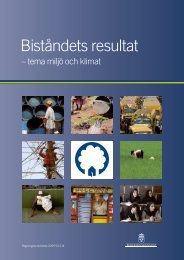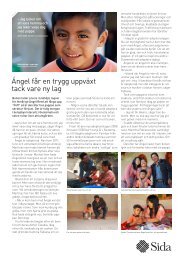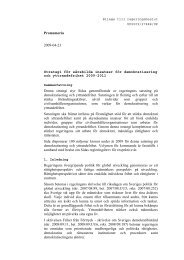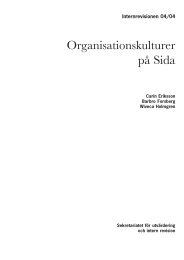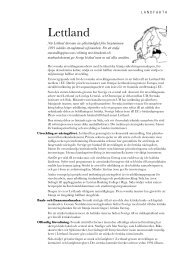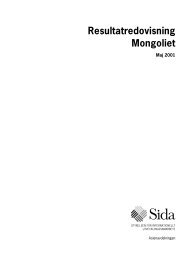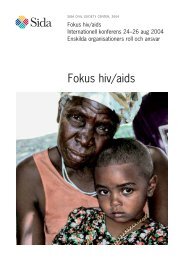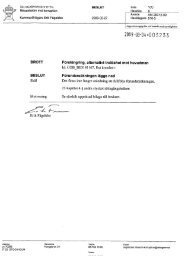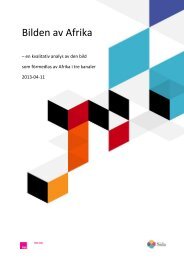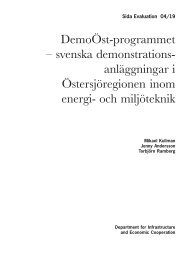Mid-Term Review of the AGIR Programme - Sida
Mid-Term Review of the AGIR Programme - Sida
Mid-Term Review of the AGIR Programme - Sida
You also want an ePaper? Increase the reach of your titles
YUMPU automatically turns print PDFs into web optimized ePapers that Google loves.
1 I N T R O D U C T I O N<br />
1.2 EVALUATION METHODOLO GY<br />
The overall purpose <strong>of</strong> <strong>the</strong> mid-term review <strong>of</strong> <strong>AGIR</strong> is to provide “existing donors<br />
and <strong>the</strong> [<strong>AGIR</strong>] intermediaries with recommendations on how to improve <strong>the</strong> programme<br />
guidelines or <strong>the</strong> functioning <strong>of</strong> <strong>the</strong> programme to ensure more effective and<br />
efficient implementation to reach <strong>the</strong> desired outcomes and impact”. 13 Though Sweden<br />
is presently <strong>the</strong> only core donor to <strong>the</strong> programme, support from o<strong>the</strong>r donors is<br />
given to <strong>AGIR</strong> intermediaries (Denmark to SCC and Ne<strong>the</strong>rlands to Oxfam Novib) in<br />
<strong>the</strong>ir ongoing work connected to <strong>the</strong> programme.<br />
The overall analysis <strong>of</strong> <strong>the</strong> <strong>AGIR</strong> programme is to be addressed through several specific<br />
areas <strong>of</strong> inquiry (see Annex 2 for TORs):<br />
Determine <strong>the</strong> programme’s effectiveness regarding achieving results at <strong>the</strong><br />
outcome level as well as to determine <strong>the</strong> programme’s relevance and potential<br />
for impact;<br />
Assess <strong>the</strong> sustainability <strong>of</strong> <strong>the</strong> programme;<br />
Serve as a basis for decisions on continued Swedish support and <strong>the</strong> possibility<br />
<strong>of</strong> accepting more donors into <strong>the</strong> programme.<br />
Given <strong>the</strong> structure <strong>of</strong> <strong>the</strong> programme (one programme with sub-programme intermediaries<br />
partnering with local CSOs) and its focus on capacity streng<strong>the</strong>ning processes,<br />
an understanding <strong>of</strong> <strong>the</strong> different ‘spheres <strong>of</strong> influence’ within <strong>AGIR</strong> was necessary<br />
to identify and assess outcomes related to <strong>the</strong> programme approach. In light <strong>of</strong> this,<br />
<strong>the</strong> evaluation team sought to identify <strong>the</strong>se different levels <strong>of</strong> interaction and how<br />
different social actors fell within <strong>the</strong> various ‘spheres <strong>of</strong> influence’ <strong>of</strong> <strong>the</strong> programme.<br />
This perspective was critical to understanding <strong>the</strong> resulting outputs and outcomes or<br />
‘progress towards outcomes’ related to <strong>the</strong> implementation <strong>of</strong> <strong>the</strong> programme. Oftentimes,<br />
a gap can exist between what takes place in <strong>the</strong> field (CSO partner work) and<br />
its connection to <strong>the</strong> broader objectives <strong>of</strong> programmes like <strong>AGIR</strong> and <strong>the</strong> support<br />
work <strong>of</strong> <strong>the</strong> intermediaries.<br />
Within this formative mid-term review, <strong>the</strong> evaluation team has attempted to document<br />
<strong>the</strong> outcomes associated with <strong>the</strong> programme by identifying and unpacking <strong>the</strong><br />
‘pathways <strong>of</strong> change’ that run through <strong>the</strong>se different spheres <strong>of</strong> influence. Within<br />
<strong>AGIR</strong> <strong>the</strong>re are multiple spheres between a donor such as <strong>Sida</strong> (Swedish International<br />
Development Agency), <strong>the</strong> intermediaries with whom it works, and <strong>the</strong> local CSO<br />
partners that work with <strong>the</strong> individuals (beneficiaries) and families influenced by <strong>the</strong><br />
work <strong>of</strong> <strong>the</strong> CSOs (see adjacent diagram).<br />
13 <strong>AGIR</strong> <strong>Mid</strong> term <strong>Review</strong>, ToRs.<br />
25




